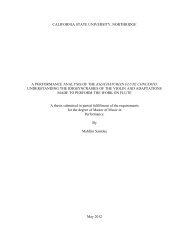2644 - CSUN ScholarWorks - California State University, Northridge
2644 - CSUN ScholarWorks - California State University, Northridge
2644 - CSUN ScholarWorks - California State University, Northridge
You also want an ePaper? Increase the reach of your titles
YUMPU automatically turns print PDFs into web optimized ePapers that Google loves.
I<br />
1-<br />
58 · journal of Student Research Abstracts<br />
leaves, number of bunches, discolored leaves, and physical observations were taken. Results such as length of<br />
leaves were not taken. This is mainly because there would be no significant growth since the duckweed were<br />
already full-grown when obtained. Following approximately two weeks of observations and measurements, I<br />
found that the potassium did not increase the multiplication or growth. It actually killed a large population of<br />
duckweed in each experimental tray. After a statistical analysis of the data, I concluded that the 1% solution<br />
of potassium nitrate, KN0 3 , decreased the rate at which duckweed multiplied. (P < 0.01)<br />
2768<br />
THE EFFECTS OF liGHT INTENSITY ON THE EATING HABITS OF BROWN<br />
GARDEN SNAilS.<br />
Jackson Thach and Steve DeGusta (teacher). John F. Kennedy High School, 6715 Gloria Dr., Sacramento,<br />
CA 95831.<br />
In this experiment, I wanted to find out if light intensity affected the amount of food eaten by Helix aspera,<br />
or the brown garden snail. To do this, I took twenty snails and separated half of them into two different categories:<br />
light and dark. Each category was named for the light intensity chosen. The snails were placed into two<br />
containers, with ten snails in each. In the dark category, the container was placed in a paper bag to encourage<br />
low light intensity. In the light category, no bag was placed over the container so that all the light would be<br />
able to pass through. I fed the snails in each category lettuce. I weighed the lettuce before and after I fed the<br />
snails to see how much they ate. My results suggested that the snails in light ate more than the snails in the<br />
dark. On average, the amount of lettuce ate by the snails in light was 7.47 grams per day. For the ones in the<br />
dark, it was 5.89 grams per day. But after using the t-test, I resolved that my data collected was due to chance<br />
(p>O.l). Therfore, I conclude that light intensity does not affect the amount of food eaten by Helix aspera.<br />
2769<br />
THE EFFECTS OF EGG YOlK AND CITRIC ACID ON THE BEHAVIOR OF<br />
DUCES/A TIGRINA<br />
Ryan D. Fong, Stephen DeGusta (teacher). John F. Kennedy High School, 6715 Gloria Drive, Sacramento,<br />
CA 95831.<br />
In this investigation, I completed a series of labs to test the effects of egg yolk and citric acid on the<br />
approach and avoidance patterns of the planarian, Dugesia tigrina. I hypothesized that the planaria would<br />
respond to egg yolk, a food source, with an approach behavior, and respond to the citric acid, a toxic substance,<br />
with an avoidance behavior. Placing planarians in a y-maze with egg yolk and citric acid in left branch in two<br />
separate tests measured this. The left and right decisions made by the planarians were recorded. A left decision<br />
would indicate approach behavior, whereas a right decision would indicate avoidance behavior. The data<br />
showed that there was no significant difference between the number of left and right decisions when egg yolk<br />
was present, but it also showed that there were significantly more right decisions compared to left when citric<br />
acid was present (X 2 =9.8, p=.01). This suggested avoidance behavior. The second experiment was to test the<br />
effects of citric acid on planarians conditioned with electric shock. They were conditioned to go left in a ymaze,<br />
by shocking them every time they chose right. Citric acid was then placed on the left. The number of<br />
left and right decisions were recorded and statistically analyzed. The data showed that there were significantly<br />
more right decisions (X 2 =5.0, p=.05). This showed that the avoidance behavior to citric acid was stronger<br />
than to electric shock.













